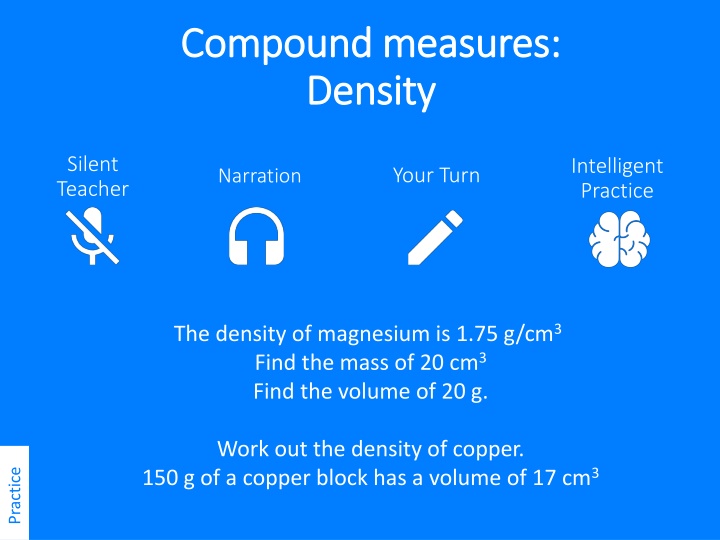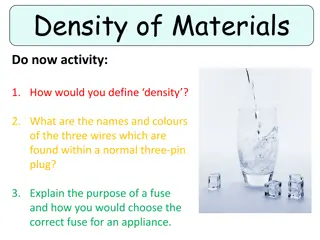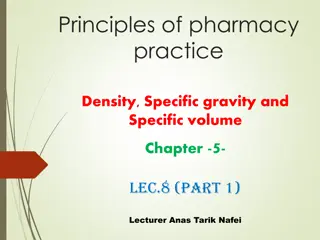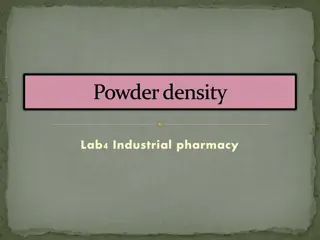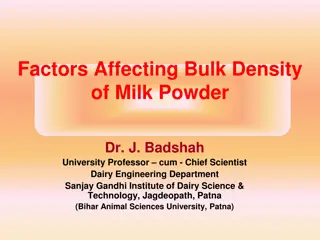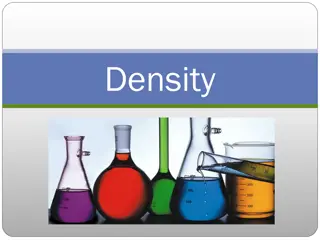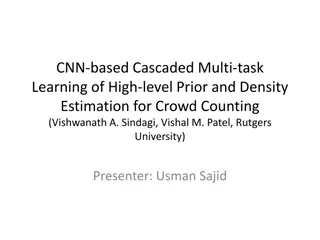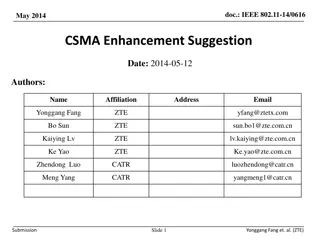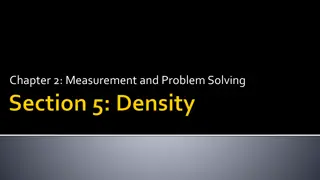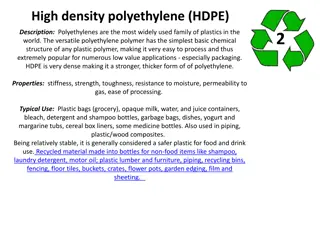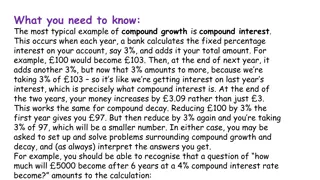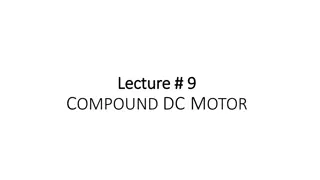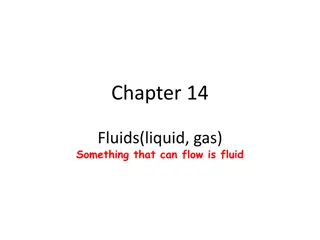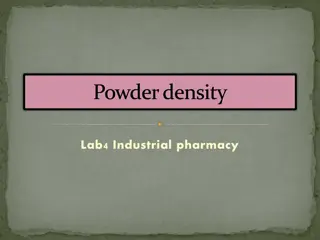Compound measures: Compound measures: Density Density
In this study material, you will learn how to apply the concept of density in real-life scenarios. The content covers topics such as calculating mass and volume, determining density of materials like magnesium and gold, and solving related problems. Engage with worked examples and practice questions to enhance your understanding of compound measures and density calculations.
Download Presentation

Please find below an Image/Link to download the presentation.
The content on the website is provided AS IS for your information and personal use only. It may not be sold, licensed, or shared on other websites without obtaining consent from the author.If you encounter any issues during the download, it is possible that the publisher has removed the file from their server.
You are allowed to download the files provided on this website for personal or commercial use, subject to the condition that they are used lawfully. All files are the property of their respective owners.
The content on the website is provided AS IS for your information and personal use only. It may not be sold, licensed, or shared on other websites without obtaining consent from the author.
E N D
Presentation Transcript
Compound measures: Compound measures: Density Density Silent Teacher Intelligent Practice Your Turn Narration The density of magnesium is 1.75 g/cm3 Find the mass of 20 cm3 Find the volume of 20 g. Work out the density of copper. 150 g of a copper block has a volume of 17 cm3 Practice
Worked Example Your Turn The density of magnesium is 1.75 g/cm3 Find the mass of 10 cm3 The density of magnesium is 1.75 g/cm3 Find the mass of 20 cm3 1.75 g @stevebishop100
The density of magnesium is 1.75 g/cm3 Find the mass of the following volumes of magnesium 1. 1 cm3 2. 10 cm3 3. 100 cm3 4. 20 cm3 5. 200 cm3 6. 0.2 cm3 The density of gold is 19.3 g/cm3 Find the mass of the following volumes of gold 7. 1 cm3 8. 100 cm3 9. 2 cm3 10. 20 cm3 11. 200 cm3 12. 0.2 cm3 @stevebishop100
The density of magnesium is 1.75 g/cm3 Find the mass of the following volumes of magnesium ANSWERS 1.75 g 17.5 g 175 g 35 g 350 g 0.35 g 1. 1 cm3 2. 10 cm3 3. 100 cm3 4. 20 cm3 5. 200 cm3 6. 0.2 cm3 The density of gold is 19.3 g/cm3 Find the mass of the following volumes of gold 19.3 g 1930 g 38.6 g 386 g 3860 g 3.86 g 7. 1 cm3 8. 100 cm3 9. 2 cm3 10. 20 cm3 11. 200 cm3 12. 0.2 cm3 @stevebishop100
Worked Example Your Turn The density of magnesium is 1.75 g/cm3 Find the volume of 10 g The density of magnesium is 1.75 g/cm3 Find the volume of 20 g 5.71 cm3 @stevebishop100
The density of magnesium is 1.75 g/cm3 Find the volume of the following masses of magnesium 1. 1 g 2. 10 g 3. 100 g 4. 2 g 5. 200 g 6. 0.2 g The density of gold is 19.3 g/cm3 Find the volume of the following masses of gold 7. 1 g 8. 100 g 9. 2 g 10. 20 g 11. 200 g 12. 0.2 g @stevebishop100
The density of magnesium is 1.75 g/cm3 Find the volume of the following masses of magnesium ANSWERS (2 decimal places) 0.57 cm3 5.71 cm3 57.14 cm3 1.14 cm3 114.29 cm3 0.11 cm3 1. 1 g 2. 10 g 3. 100 g 4. 2 g 5. 200 g 6. 0.2 g The density of gold is 19.3 g/cm3 Find the volume of the following masses of gold 0.05 cm3 5.18 cm3 0.10 cm3 1.04 cm3 10.36 cm3 0.01 cm3 7. 1 g 8. 100 g 9. 2 g 10. 20 g 11. 200 g 12. 0.2 g @stevebishop100
Worked Example Your Turn Work out the density of gold. 97 g of gold has a volume of 5 cm3 Work out the density of copper. 150 g of a copper block has a volume of 17 cm3. 19.4 g/cm3 @stevebishop100
Calculate the density of the following materials given their mass and their volume 1. Aluminium: 45 cm3 has a mass of 120 g 2. Brass: 117 cm3 has a mass of 1000 g 3. Bronze: 60 cm3 has a mass of 500 g 4. Copper: 17 cm3 has a mass of 150 g 5. Lead: 18 cm3 has a mass of 200 g 6. Magnesium: 57 cm3 has a mass of 100 g 7. Mercury: 9 cm3 has a mass of 120g 8. Nylon: 118 cm3 has a mass of 200 g 9. Rubber: 67 cm3 has a mass of 80 g 10. Silver: 4.8 cm3 has a mass of 50 g 11. Zinc: 7 cm3 has a mass of 50 g @stevebishop100
Calculate the density of the following materials given their mass and their volume 1. Aluminium: 45 cm3 has a mass of 120 g 2. Brass: 117 cm3 has a mass of 1000 g 3. Bronze: 60 cm3 has a mass of 500 g 4. Copper: 17 cm3 has a mass of 150 g 5. Lead: 18 cm3 has a mass of 200 g 6. Magnesium: 57 cm3 has a mass of 100 g 7. Mercury: 9 cm3 has a mass of 120g 8. Nylon: 118 cm3 has a mass of 200 g 9. Rubber: 67 cm3 has a mass of 80 g 10. Silver: 4.8 cm3 has a mass of 50 g 11. Zinc: 7 cm3 has a mass of 50 g ANSWERS (2dp) 2.67 g/cm3 8.55g/cm3 8.33 g/cm3 8.82 g/cm3 11.11 g/cm3 1.75 g/cm3 13.3 g/cm3 1.69 g/cm3 1.19 g/cm3 10.41 g/cm3 7.14 g/cm3 @stevebishop100
